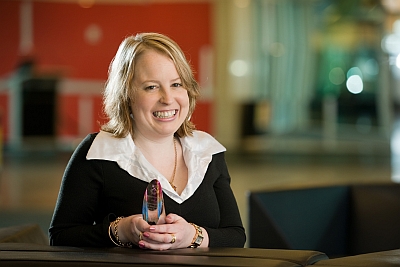Allyson Croxford was first diagnosed with rheumatoid arthritis at age 10. Now she’s close to finishing a PhD that could potentially lead to new treatments or earlier diagnosis for this surprisingly common condition.
Around one in 100 Australians, including some young children, suffer from rheumatoid arthritis. A debilitating autoimmune disease in which the body’s own immune system attacks and damages the lining of ankles, wrists and other joints, rheumatoid arthritis is characterised by joint pain, swelling and stiffness.
“It affects everyday activities such as walking or even opening a door, the kinds of things that most other people take for granted as easy to do,” says Allyson. “Cold weather and sudden changes in the weather are bad for me, although the triggers vary from person to person.”
The condition is not well understood and there is currently no cure although new medicines have helped sufferers improve their quality of life. After enduring years of unpleasant side effects from a cocktail of medications, Allyson now manages her condition with weekly injections of a new “miracle drug” and daily doses of anti-inflammatories.
Allyson‘s research group at Monash University, led by her PhD supervisor Merrill Rowley, is using a mouse model to investigate how antibodies to a particular kind of collagen (type II) might affect rheumatoid arthritis. Collagen is a major component of cartilage, the joint tissue affected by rheumatoid arthritis.
“The mouse is as close as you can get without using humans,” Allyson says. “Some human patients have antibodies with the same specificity as those we use, which suggests the antibodies actually play a significant role and that the disease is not just an inflammatory condition.”
The Monash University team is collaborating with Swedish researchers, who have used the mouse model to identify where the antibodies bind to the collagen in cartilage. Different binding sites are associated with different degrees of severity.
Allyson’s contribution is to use the infrared microspectroscopy beamline at the Australian Synchrotron to investigate the minute chemical changes that take place before there is any visible sign of cartilage damage and the onset of rheumatoid arthritis symptoms.
“The synchrotron resolution is excellent. It enables us to examine the cells themselves and the direct effects of the antibodies binding to the collagen,” says Allyson. “We look closely at the position of a particular peak in the infrared spectrum; the amide I peak. As the collagen is gradually destabilised, its structure begins to uncoil and the peak shifts position.
“I’ve used synchrotron infrared microspectroscopy more and more as my PhD has progressed because I’ve realised what a powerful technique it is,” Allyson says. “I would love to work at the synchrotron.”
By examining pieces of cartilage sourced from local abattoirs and treating them with the antibodies, Allyson has shown that the collagen type II antibodies are associated with collagen damage in cartilage where the immune system is not involved.
Her synchrotron work with samples from the Swedish mice suggests that the damage by the antibodies occurs before inflammation. This discovery could help point the way to new drugs for treating the condition, or to more effective detection methods that would enable early treatment and improved outcomes for patients.
In 2009, Allyson’s passion for her research was put under the spotlight when she won a competition designed to test how well Monash University PhD students could present their research in just three minutes.
“I just entered the competition to have a go,” she says. “Winning was such a boost to my confidence. Ever since I won the award, people want to know me.”
Allyson plans to submit her PhD thesis later this year.

Allyson Croxford with her '3-minute thesis' award. Photo: Monash University
